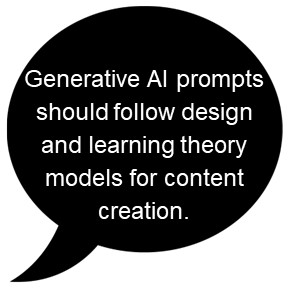Author: Anastasia Bojanowski, University of Central Florida
Editor: Dr. Denise Lowe, University of Central Florida
Dear ADDIE,
Some of my colleagues are leveraging Generative AI for content creation. I have content that needs to be updated and would like to use AI platforms. However, I soon became overwhelmed when I searched for options. Further, I have reservations regarding the accuracy and reliability of AI platforms. Any suggestions?
Lost in the Matrix
Dear Lost in the Matrix,
I can sympathize with feeling overwhelmed when considering AI platforms for content creation. The options are plentiful. You are also wise to question the accuracy and reliability of content creation. Indeed, the rate of Generative AI to hallucinate or invent information is estimated to be between 3-27% (Metz, 2023). Further, the output can contain biases and misinformation (Zewe, 2023). However, with a healthy level of pragmatism, Generative AI has a place in content creation if users follow the ASSURE and ADDIE models and include design and learning theory in prompts.
When updating content, consider using the design features of platforms and applications. For example, older PowerPoints can be refreshed with a newer theme, stock images, and the “Designer” feature native to the program. Additionally, presentations can be uploaded into free versions of Google’s Gamma, Adobe Express (webpage), and Canva.

Another option is to use platforms such as Microsoft’s Copilot or Open AI’s ChatGPT to generate an initial draft of anything from lesson plans to grading rubrics. Consider experimenting with each by using the same prompt and vetting results. Regardless of the selection of the platform, the prompt should be composed to include instructional design and learning theory. Christie (2024) recommends constructing prompts that include Gagné’s (1985) events of instruction:
- Gaining attention
- Informing the learner of the objective
- Stimulating recall of prerequisite learning
- Presenting the stimulus material
- Providing learning guidance
- Eliciting the performance
- Providing feedback
- Assessing the performance
- Enhancing retention and transfer
| Prompt using Gangé’s Events of Instruction: You are an expert in creating an exercise supporting experiential and active learning. The activity requires peer collaboration for an asynchronous online course and is based on the creation and review of a digital portfolio for professional purposes. Students will be sorted into groups of 3 for peer review. Upon completion of the activity, students will create a digital portfolio that includes a skills-based resume, statement of philosophy, projects, and community service. Afterward, students will be asked to provide feedback on design and content. The activity is a 3-week activity. Please create a brief yet compelling description of the activity that can be posted in Canvas as an introduction. Create step-by-step directions to create a digital portfolio that includes content pages for the following: skill-based resume, personal statement, projects, and community service, and contact. Include any resources that can help create a college student digital portfolio. Create a peer review worksheet that students can use to evaluate design and content. Make sure that the worksheet can be filled out online. Generate a grading rubric that evaluates design, skills-based resume, alignment of skills-based resume with projects, and peer review. Consider each part of the instructions given and generate the most engaging lesson. |
Keep in mind that the generated lesson may require several iterations to achieve the desired output. Further, the output is an initial draft that requires vetting for accuracy and integrity and adding legitimate resources. Output requires careful review to support universal design principles, protect privacy, and avoid bias.
The one platform that lists sources used to generate output is Microsoft’s Copilot. A follow-up prompt that asks for specific sites or resources to be included has mixed results. Consequently, the problem with legitimacy and accuracy persists.
Moving forward, content creators should require Generative AI platforms to safeguard privacy and provide robust bias reviews—even with free versions of their platforms. Just as textbook companies were forced to ensure universal design to accommodate learners with disabilities to remain competitive, Generative AI platforms should protect privacy and minimize bias to be a viable candidate for content creation.
What other ideas or plans for the inclusion of AI have you applied or are exploring at your higher education institution? Please share your thoughts with our TOPkit community on LinkedIn!
References
Christie, B [Alchemy]. (2024, January 17). AI for the new year: Integrating AI into academic work [Video]. YouTube. https://www.youtube.com/watch?v=Lx0gGJ18MlI
Gagné, R. M. (1985). The conditions of learning and theory of instruction (4th ed.). Holt, Rinehart & Winston.
Metz, C. (2023, November 16). Chatbots may ‘hallucinate’ more often than many realize. The New York Times. https://www.nytimes.com/2023/11/06/technology/chatbots-hallucination-rates.html
Zewe, A. (2023, November 9). Explained: Generative AI: How do powerful generative AI systems like ChatGPT work, and what makes them different from other types of artificial intelligence? MIT News. https://news.mit.edu/2023/explained-generative-ai-1109
